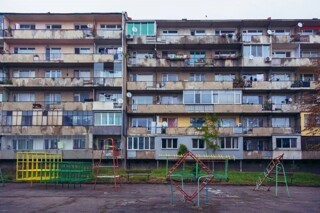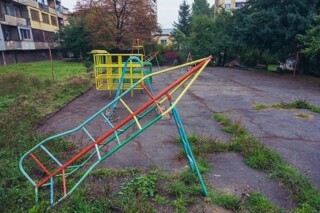In the Communist Playground
Neda Neynska
In one of the oldest playgrounds in Sofia, where I grew up, there are some new toddler attractions among the old rusting ones, but the potholes in the tarmac haven’t been repaired. For the last six years, flowers have been appearing in them, as part of an ongoing project devised by the artist Veronika Tzekova. She calls it WUMAMPAROI (‘When you make a mistake put a rose on it’). We are a long way from the Soviet cult of childhood, in which the playground played a key role, shifting children’s emotional focus away from home and setting them on the road to the Party.
When Mikhail Gorbachev took power, Komsomol, the Soviet youth organisation, had more than 42 million members. At the age of 14, children across the Soviet Union and the Eastern Bloc became komsomoltsi. Many Bulgarian children had been Septemberists since the age of six, and Pioneers at ten. As Lenin understood, the sooner you start, the better.
The vast, ideologically charged infrastructure that supported the youth organisations was where socialism in Bulgaria came to life: the communal youth homes (mladejki dom), the pioneer camps and cultural and labour brigades, the sports halls and playgrounds, all financed by the state and free for children.
Most playgrounds like the ones I was taken to in Sofia as a child now look like archaeological sites, the remains of a civilisation that came to an abrupt end. We were catapulted out of the structured environment of the ‘advanced socialist society’ into a world of ‘choice’, where there seemed to be very few choices. We were left with the relics of a grand idea: wide boulevards, monolithic architectural projects, empty palaces of culture, space-themed jungle gyms. But even before 1989 it had all begun to look dated, and defeated. Gagarin and Tereshkova were ancient and drab; we had seen Lego and Barbie.
In the spirit of egalitarianism, all playgrounds were designed to look the same: celebrations of Soviet ironmongery and ideology. Spacecraft were intermingled with boats and tractors. There were animals, too, and here was a difference I spotted early on: the nearer you were to an affluent part of town, the more exotic the species were likely to be. I never understood what the elephant was doing there; space seemed a more realistic destination than the African savannah.
After the fall of communism, the youth centres closed down as the organisations they represented became defunct. But no one thought of playgrounds as politicised spaces: they survived into the post-communist era, with minimal upkeep, and remained important for local communities. Parents and minders had always been able to talk freely there, sitting on benches under awning-like structures without any actual awnings. They suggested shelter, but did not provide it.
Playground benches were used by the former Pioneers and komsomoltsi to barricade the streets when Bulgaria’s last socialist government was brought down.


Comments